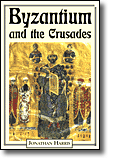During his pontificate, one of John Paul II’s chief goals was to improve relations with the Orthodox Church, making reunion a more viable possibility. Only certain pontiffs during the medieval period were comparable to his efforts in this matter. Like John Paul II, Pope Urban II was also committed to improving relations with the Orthodox Church. In fact, Urban conceived of the Crusades in part as a tool to reunite the Roman and Orthodox Churches, which had been in schism since 1054. In answering Byzantine pleas for assistance against the Muslims (though not the type of assistance the emperor expected), the pope envisioned this as an opportunity to mend the recent rift between East and West.  Ironically, the Crusades ultimately helped cement the chasm between the two. In Byzantium and the Crusades, Jonathan Harris examines the often–tense relationship between the Byzantine Empire and the crusading movement, arguing that the failure here was due to Byzantium’s stubborn adherence to its traditional foreign policy when dealing with the crusaders.
Ironically, the Crusades ultimately helped cement the chasm between the two. In Byzantium and the Crusades, Jonathan Harris examines the often–tense relationship between the Byzantine Empire and the crusading movement, arguing that the failure here was due to Byzantium’s stubborn adherence to its traditional foreign policy when dealing with the crusaders.
For Harris, the growing antagonism between the East and the West was rooted in the foreign policy of the Byzantine Empire and the ideology that underpinned it. He believes that Byzantine foreign policy had two key elements: the security of the Empire, especially that of Constantinople, and the recognition of the Byzantine emperor’s claim as being the preeminent Christian ruler. Byzantine foreign policy was essentially defensive and ideological, usually relying on negotiation instead of warfare to secure these primary aims. In dealing with foreigners, the Byzantine emperors utilized what Harris describes as the “two pillars” approach—bestowing money and honors on foreigners while emphasizing that they were subservient to the emperor.
Alexius I Comnenus used this traditional approach when he dealt with the leaders of the First Crusade. He bestowed riches and honors on them, but also made them swear oaths, which guaranteed the security of the empire and demonstrated their subservience to Alexius. The crusaders, though, were irritated by this treatment (since they saw themselves as coming to help the emperor) and mystified by how Alexius seemed more concerned about the safety of Constantinople than the liberation of Jerusalem. Moreover, when Alexius failed to come to the aid of the crusaders at the siege of Antioch, he alienated these potential partners and prevented the city (once the crusaders captured it) from returning to the Byzantine fold. In the coming years, Antioch would play, a central role in the relationship between the Byzantine Empire and the crusader states—as various emperors continually attempted to bring the city back under Byzantine control, thus creating further tension between Byzantium and the West.
Jerusalem would also be an awkward aspect of this relationship. Prior to the First Crusade, the Byzantine emperor was regarded as the protector of the Holy Sepulchre. Byzantine rulers regularly provided money for the maintenance of Christian shrines while the holy city was under Muslim rule. The capture of Jerusalem in 1099 not only ended this, but it also brought about the emergence of the Latin Kingdom of Jerusalem—a Christian state independent of Byzantine authority. The emperors, however, wanted to reassert Byzantine patronage over the holy places here, in part, because this function helped underscore the emperor’s claim of being above all other Christian monarchs.
As the events of 1204 were a pivotal point in Byzantine–Western relations, the Fourth Crusade naturally is one of the main focuses of the book. Unfortunately, the author’s discussion of these events is extremely flawed. He rejects the “accident” theory—the sack of Constantinople was the result of a series of missteps by the crusaders, not a secret conspiracy—which most crusade scholars today accept. Harris claims that this explanation fails to explain how the sack occurred because it supposedly suggests that human beings do not have control of their own destiny. At best, this assessment is a misunderstanding of the “accident” theory; at worst, it is a ridiculous distortion so as to justify a new theory. The “accident” theory does not remove free will from the equation. Those who support this interpretation do not suggest that the crusaders never chose to attack Constantinople at some point, but they maintain that the derailment of the crusade to Constantinople was rooted in a series of mistakes and missteps, not premeditation. Furthermore, Harris neglects to mention that the crusaders originally intended to restore Alexius IV (who had asked for their assistance) and his father to the imperial throne in order to receive Byzantine financial and military assistance for the crusade.
This new study by Jonathan Harris is mainly useful in showing that the disastrous relationship between the Byzantine Empire and the crusading movement was not the inevitable outcome of the bitterness and rivalry that began in 1054 or a clash of civilizations. However, his belief that this deterioration was the result of Byzantium’s attempt to implement their traditional foreign policy in circumstances that left their actions open to misinterpretation by the crusaders or the West is by itself an unconvincing premise. Moreover, the book is marred by his botched discussion of the Fourth Crusade. For a first-rate discussion of this topic, which is at the heart of the Byzantine-Crusades issue, one would be better served to consider the work of a different Jonathan—Jonathan Phillips and his recent book, The Fourth Crusade and the Sack of Constantinople.
Vincent Ryan
St. Louis University
Recent Comments